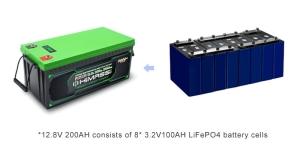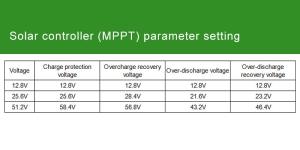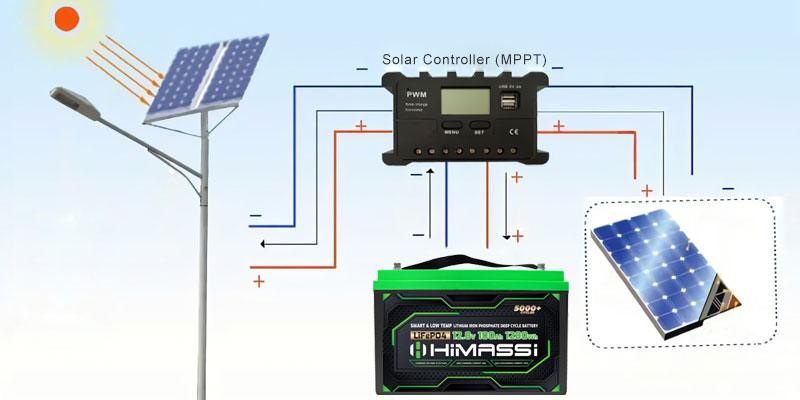How to Set Parameters for Solar Controllers (MPPT)
How to Set Parameters for Solar Controllers (MPPT)
Introduction
Solar controllers are an indispensable component of any solar power system. They not only protect batteries from overcharging or deep discharge but also ensure maximum efficiency output from solar panels. Maximum Power Point Tracking (MPPT) controllers stand out for their superior energy conversion capabilities. This article provides detailed guidance on setting MPPT parameters for various lithium iron phosphate (LiFePO4) battery configurations, helping you optimize the performance of your solar energy systems.
Solar energy, by its nature, fluctuates due to changes in sunlight exposure caused by weather variations and the day’s time. MPPT technology plays a crucial role in managing these fluctuations by adjusting the charge sent to the batteries to capture the maximum possible energy at any given time. By understanding how to precisely set up your MPPT controller, you can significantly improve the efficiency and longevity of your solar energy system.

Fundamentals of MPPT Controllers
MPPT, or Maximum Power Point Tracking, is an advanced charging technique that dynamically adjusts the charge process to maximize the efficiency of solar panels. The core function of an MPPT controller is to find the panel’s maximum power point and adjust the load accordingly to optimize the energy harvested from the sun. This technology is particularly beneficial in environments with variable weather conditions or partial shade.
Compared to traditional PWM (Pulse Width Modulation) controllers, MPPT controllers operate at a higher efficiency level. While PWM controllers are generally cheaper and simpler, they do not adjust to changing light conditions, leading to potential energy losses when solar irradiance levels fluctuate. On the other hand, MPPT controllers continuously adjust their input to deliver the maximum possible energy to the batteries, making them ideal for areas with inconsistent sunlight.
MPPT controllers can increase charge efficiency by up to 30% compared to PWM models, especially in colder or overcast climates where sunlight is less direct or filtered through clouds. This efficiency is achieved by electronically tracking the panels’ voltage and current in real-time and adjusting the voltage to match the battery’s state of charge, maximizing energy transfer.
Setting MPPT Controller Parameters: A Step-by-Step Guide
Properly setting the parameters of an MPPT solar controller is crucial for ensuring the efficient operation of your solar power system. Here’s a detailed guide on how to configure the settings for various lithium iron phosphate (LiFePO4) battery configurations:
- Identifying System RequirementsBefore you begin adjusting your MPPT controller, it is vital to understand your solar system’s specific needs, including total system voltage and the type of batteries used. LiFePO4 batteries, known for their robustness and longevity, require specific settings for optimal performance.
- Basic Parameter Settings for Different Battery ConfigurationsThe settings for your MPPT controller will vary depending on the number of cells in series within your battery pack. Here’s how to adjust the controller for common configurations:
- 8-series LiFePO4 Battery (12.8V)
- Charge Protection Set Point: Set this parameter to 14.6V to prevent overcharging, which can extend battery life.
- Overcharge Recovery: Reset the charging process to 14.2V to allow the battery to stabilize before resuming normal charging.
- Discharge Protection: Establish a low-voltage cutoff at 10.8V to protect the battery from deep discharges.
- Discharge Recovery: Set this to 11.6V to allow the battery to recover before it starts accepting charge again.
- 16-series LiFePO4 Battery (25.6V)
- Charge Protection Set Point: Adjust this to 29.2V to ensure the battery charges safely without exceeding its voltage limit.
- Overcharge Recovery: Set to 28.4V to reduce the voltage slightly once the upper limit is reached, protecting the cells from stress.
- Discharge Protection: A threshold of 21.6V will prevent the battery from discharging too deeply, thus preserving its capacity.
- Discharge Recovery: Configure this to 23.2V to provide a safe margin for battery recovery after discharge.
- 32-series LiFePO4 Battery (51.2V)
- Charge Protection Set Point: This should be set at 58.4V to optimize charging without surpassing the maximum voltage of the battery pack.
- Overcharge Recovery: Reduce the setting to 56.8V to allow the battery to normalize post-charging.
- Discharge Protection: Set the low-voltage cutoff at 43.2V to safeguard the battery’s long-term health.
- Discharge Recovery: Adjust to 46.4V to ensure the battery can recover effectively after being deeply discharged.
- Advanced Parameter AdjustmentsBeyond basic voltage settings, MPPT controllers offer advanced options that can further enhance your system’s performance. These include temperature compensation, which automatically adjusts charging parameters based on the ambient temperature to prevent overcharging in hot weather and undercharging in cold. Load control is another sophisticated feature that enables the user to manage power usage by automatically turning off non-critical loads during low battery conditions, thus ensuring that essential functions continue without interruption.
Advanced Parameter Adjustments
Advanced settings in MPPT controllers allow for fine-tuning beyond basic voltage thresholds, enhancing system performance and adapting to specific environmental conditions:
- Temperature Compensation: This feature adjusts the charging voltage based on the ambient temperature. Temperature compensation is critical because battery charging requirements change with temperature fluctuations. For instance, in colder environments, the charging voltage should be higher to adequately charge the battery, whereas in hotter conditions, it should be lowered to prevent overcharging and potential damage.
- Load Control: This function allows for the strategic management of output loads. You can set the controller to disconnect non-essential loads when the battery voltage drops below a predefined threshold, thereby preserving battery life and ensuring critical components remain operational. Load control is especially useful in systems where power demands vary significantly throughout the day or where certain applications are prioritized over others.
Troubleshooting and Maintenance
Maintaining the efficiency and longevity of your solar power system involves regular troubleshooting and maintenance of the MPPT controller. Here are some common issues and solutions:
- Low Charging Efficiency: If the system seems to be generating less power than expected, first check the alignment and cleanliness of solar panels. Dust, debris, or misalignment with the sun can significantly reduce efficiency. Next, verify the wiring and connections for corrosion or damage, as poor connections can impede power flow.
- Battery Not Charging Fully: This issue may arise from incorrect parameter settings on the MPPT controller. Recheck the voltage set points according to your specific battery’s specifications. Additionally, ensure the battery itself is in good health; aging or damaged batteries may not hold a full charge.
- System Overheating: Overheating can occur if the MPPT controller is exposed to high ambient temperatures or if it’s operating beyond its capacity. Ensure adequate ventilation around the controller and consider adding a fan or moving the system to a cooler location if necessary.
- Monitoring System Performance: Most modern MPPT controllers come equipped with monitoring tools that provide real-time data on system performance and diagnostic logs. Regularly reviewing these logs can help you identify potential issues before they become serious problems, facilitating proactive maintenance and adjustments.

Conclusion
Properly setting up and maintaining an MPPT controller is vital for maximizing the efficiency and lifespan of your solar power system. By following the detailed guidelines provided, you can ensure that your system operates at peak efficiency, reliably converting solar energy into usable power.
About Himax Electronics
Himax Electronics is a leader in the field of solar battery and control technology, offering a range of efficient solutions, including state-of-the-art MPPT controllers. Our commitment to innovation and quality ensures that our products meet the highest standards, helping customers optimize their solar energy systems. By choosing Himax, you benefit from cutting-edge technology, expert support, and dedicated customer service, making your solar investments more productive and sustainable.



